FNSBKG405 Payroll: Establishing and Maintaining a Compliant System
VerifiedAdded on 2024/06/05
|10
|2540
|361
Homework Assignment
AI Summary
This assignment solution for FNSBKG405 focuses on establishing and maintaining a payroll system. It details the types of employee data required in a payroll system, including names, addresses, schedules, and salary structures. The solution explains how to calculate hourly pay rates, addressing discrepancies, and escalating complex inquiries to payroll accountants or analysts. It outlines the steps for completing a pay run, emphasizing the importance of employee data accuracy and chronological sequencing. Furthermore, the assignment discusses the requirements for handling payroll inquiries, the necessity of adequate knowledge and communication skills, and the types of payroll information that must be kept, such as gross pay, withholding tax, and leave accruals. It also identifies essential month-end and year-end reports like payroll registers, salary analysis, and tax type reports. The solution highlights the importance of updating and backing up data for recovery, audits, and tax purposes. Finally, it addresses scenarios related to minimum wage compliance, pay slip issuance, and record-keeping requirements under the National Employment Standards and Fair Work Act. Desklib offers a variety of resources, including similar solved assignments and past papers, to support students in their studies.
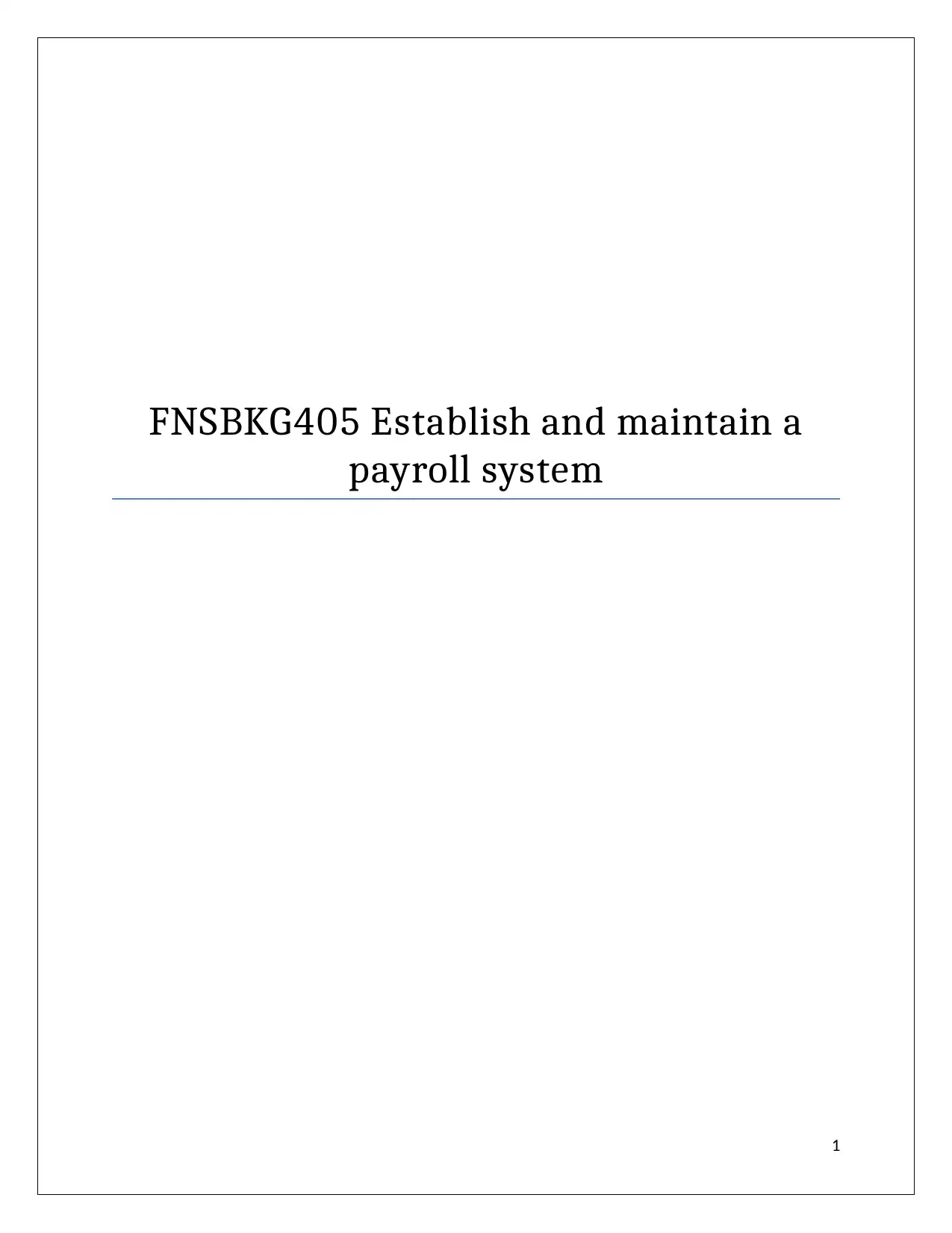
FNSBKG405 Establish and maintain a
payroll system
1
payroll system
1
Paraphrase This Document
Need a fresh take? Get an instant paraphrase of this document with our AI Paraphraser
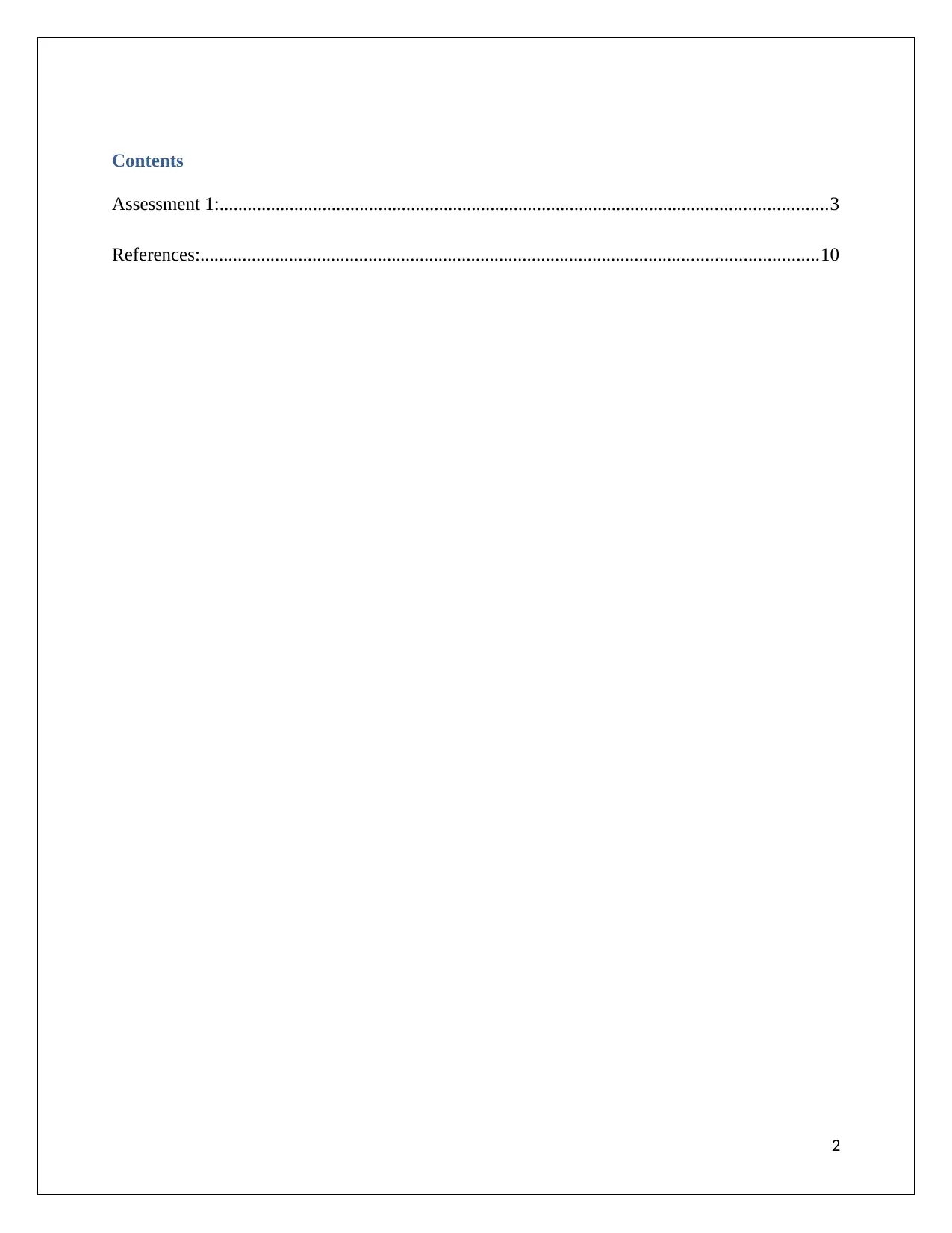
Contents
Assessment 1:..................................................................................................................................3
References:....................................................................................................................................10
2
Assessment 1:..................................................................................................................................3
References:....................................................................................................................................10
2
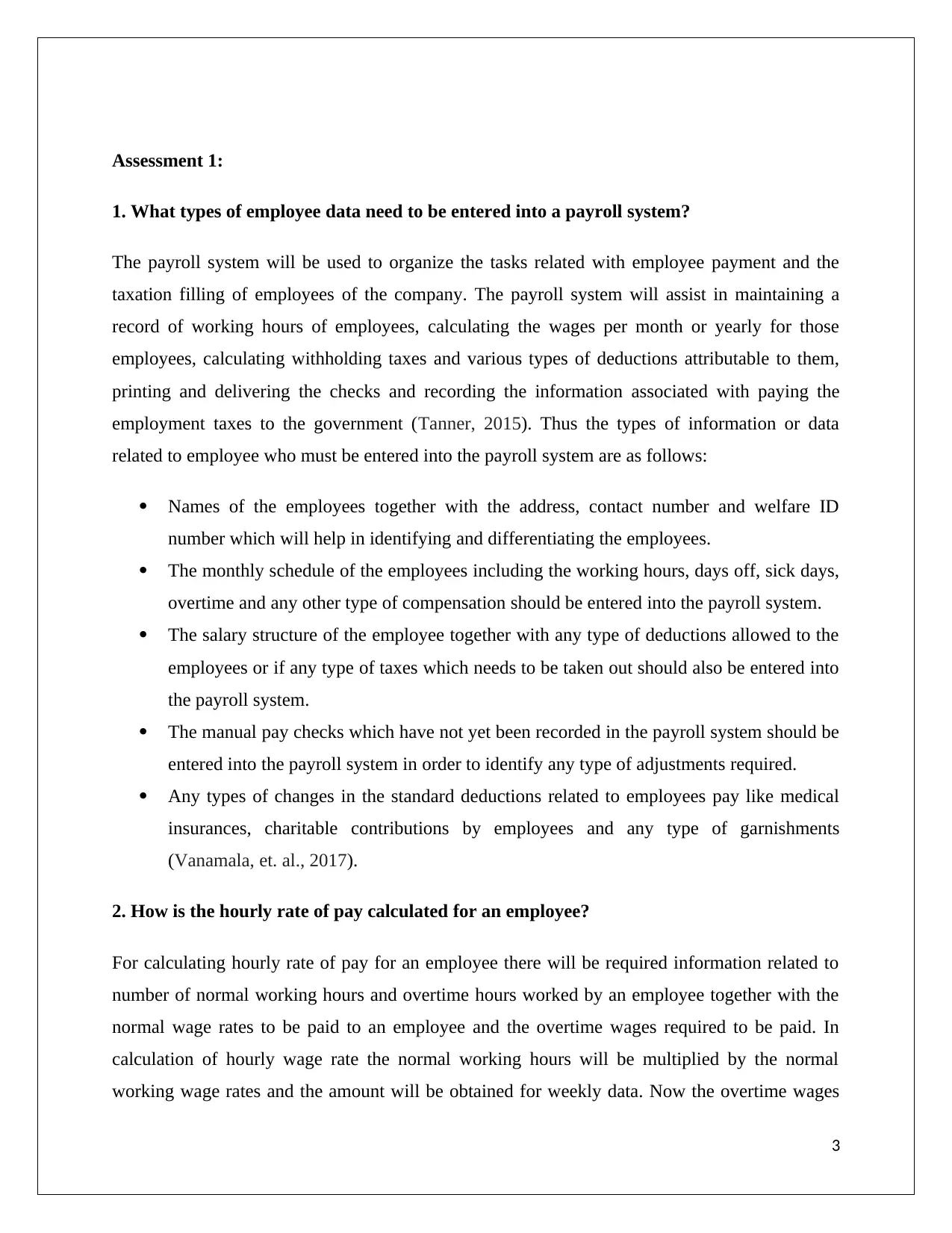
Assessment 1:
1. What types of employee data need to be entered into a payroll system?
The payroll system will be used to organize the tasks related with employee payment and the
taxation filling of employees of the company. The payroll system will assist in maintaining a
record of working hours of employees, calculating the wages per month or yearly for those
employees, calculating withholding taxes and various types of deductions attributable to them,
printing and delivering the checks and recording the information associated with paying the
employment taxes to the government (Tanner, 2015). Thus the types of information or data
related to employee who must be entered into the payroll system are as follows:
Names of the employees together with the address, contact number and welfare ID
number which will help in identifying and differentiating the employees.
The monthly schedule of the employees including the working hours, days off, sick days,
overtime and any other type of compensation should be entered into the payroll system.
The salary structure of the employee together with any type of deductions allowed to the
employees or if any type of taxes which needs to be taken out should also be entered into
the payroll system.
The manual pay checks which have not yet been recorded in the payroll system should be
entered into the payroll system in order to identify any type of adjustments required.
Any types of changes in the standard deductions related to employees pay like medical
insurances, charitable contributions by employees and any type of garnishments
(Vanamala, et. al., 2017).
2. How is the hourly rate of pay calculated for an employee?
For calculating hourly rate of pay for an employee there will be required information related to
number of normal working hours and overtime hours worked by an employee together with the
normal wage rates to be paid to an employee and the overtime wages required to be paid. In
calculation of hourly wage rate the normal working hours will be multiplied by the normal
working wage rates and the amount will be obtained for weekly data. Now the overtime wages
3
1. What types of employee data need to be entered into a payroll system?
The payroll system will be used to organize the tasks related with employee payment and the
taxation filling of employees of the company. The payroll system will assist in maintaining a
record of working hours of employees, calculating the wages per month or yearly for those
employees, calculating withholding taxes and various types of deductions attributable to them,
printing and delivering the checks and recording the information associated with paying the
employment taxes to the government (Tanner, 2015). Thus the types of information or data
related to employee who must be entered into the payroll system are as follows:
Names of the employees together with the address, contact number and welfare ID
number which will help in identifying and differentiating the employees.
The monthly schedule of the employees including the working hours, days off, sick days,
overtime and any other type of compensation should be entered into the payroll system.
The salary structure of the employee together with any type of deductions allowed to the
employees or if any type of taxes which needs to be taken out should also be entered into
the payroll system.
The manual pay checks which have not yet been recorded in the payroll system should be
entered into the payroll system in order to identify any type of adjustments required.
Any types of changes in the standard deductions related to employees pay like medical
insurances, charitable contributions by employees and any type of garnishments
(Vanamala, et. al., 2017).
2. How is the hourly rate of pay calculated for an employee?
For calculating hourly rate of pay for an employee there will be required information related to
number of normal working hours and overtime hours worked by an employee together with the
normal wage rates to be paid to an employee and the overtime wages required to be paid. In
calculation of hourly wage rate the normal working hours will be multiplied by the normal
working wage rates and the amount will be obtained for weekly data. Now the overtime wages
3
⊘ This is a preview!⊘
Do you want full access?
Subscribe today to unlock all pages.

Trusted by 1+ million students worldwide
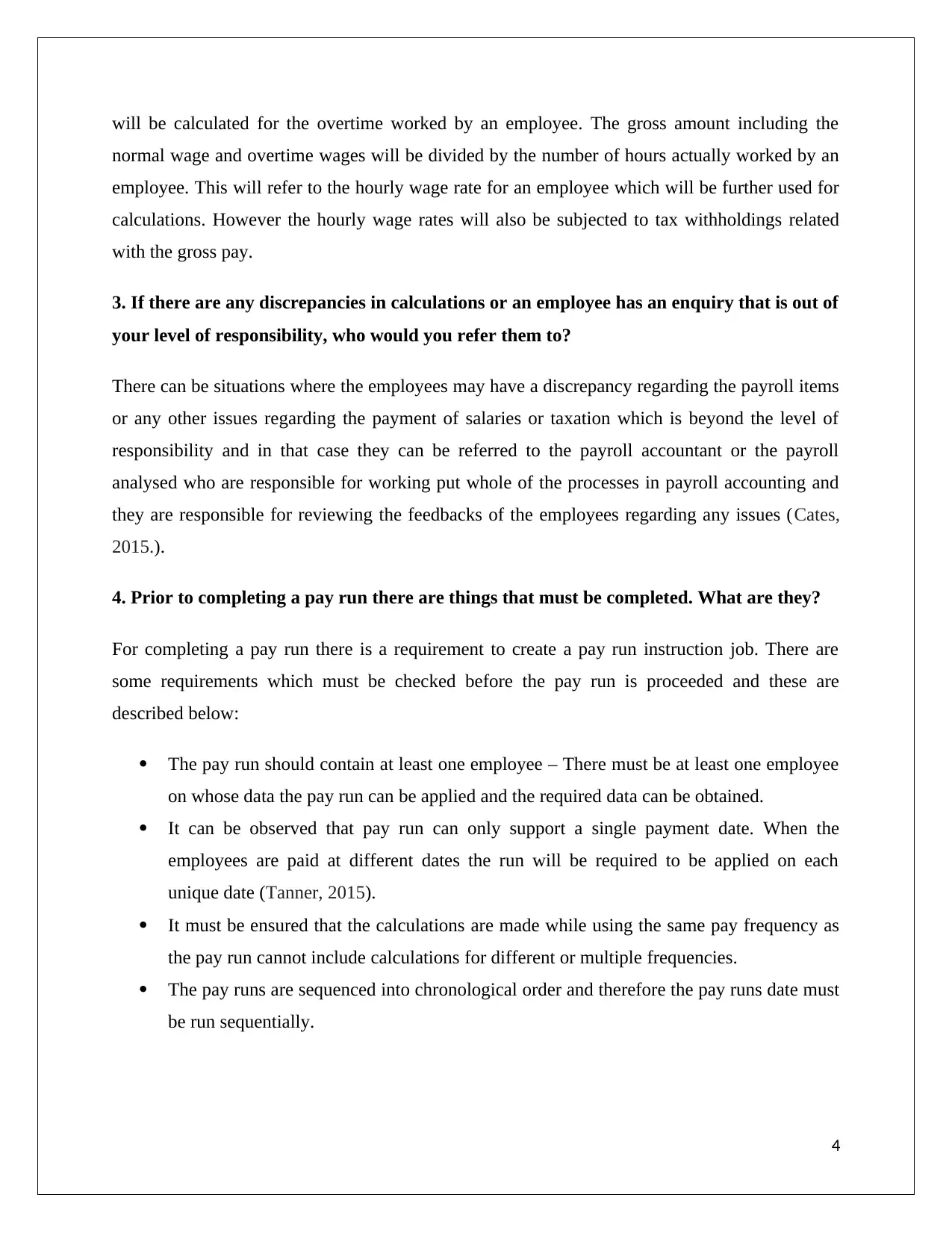
will be calculated for the overtime worked by an employee. The gross amount including the
normal wage and overtime wages will be divided by the number of hours actually worked by an
employee. This will refer to the hourly wage rate for an employee which will be further used for
calculations. However the hourly wage rates will also be subjected to tax withholdings related
with the gross pay.
3. If there are any discrepancies in calculations or an employee has an enquiry that is out of
your level of responsibility, who would you refer them to?
There can be situations where the employees may have a discrepancy regarding the payroll items
or any other issues regarding the payment of salaries or taxation which is beyond the level of
responsibility and in that case they can be referred to the payroll accountant or the payroll
analysed who are responsible for working put whole of the processes in payroll accounting and
they are responsible for reviewing the feedbacks of the employees regarding any issues (Cates,
2015.).
4. Prior to completing a pay run there are things that must be completed. What are they?
For completing a pay run there is a requirement to create a pay run instruction job. There are
some requirements which must be checked before the pay run is proceeded and these are
described below:
The pay run should contain at least one employee – There must be at least one employee
on whose data the pay run can be applied and the required data can be obtained.
It can be observed that pay run can only support a single payment date. When the
employees are paid at different dates the run will be required to be applied on each
unique date (Tanner, 2015).
It must be ensured that the calculations are made while using the same pay frequency as
the pay run cannot include calculations for different or multiple frequencies.
The pay runs are sequenced into chronological order and therefore the pay runs date must
be run sequentially.
4
normal wage and overtime wages will be divided by the number of hours actually worked by an
employee. This will refer to the hourly wage rate for an employee which will be further used for
calculations. However the hourly wage rates will also be subjected to tax withholdings related
with the gross pay.
3. If there are any discrepancies in calculations or an employee has an enquiry that is out of
your level of responsibility, who would you refer them to?
There can be situations where the employees may have a discrepancy regarding the payroll items
or any other issues regarding the payment of salaries or taxation which is beyond the level of
responsibility and in that case they can be referred to the payroll accountant or the payroll
analysed who are responsible for working put whole of the processes in payroll accounting and
they are responsible for reviewing the feedbacks of the employees regarding any issues (Cates,
2015.).
4. Prior to completing a pay run there are things that must be completed. What are they?
For completing a pay run there is a requirement to create a pay run instruction job. There are
some requirements which must be checked before the pay run is proceeded and these are
described below:
The pay run should contain at least one employee – There must be at least one employee
on whose data the pay run can be applied and the required data can be obtained.
It can be observed that pay run can only support a single payment date. When the
employees are paid at different dates the run will be required to be applied on each
unique date (Tanner, 2015).
It must be ensured that the calculations are made while using the same pay frequency as
the pay run cannot include calculations for different or multiple frequencies.
The pay runs are sequenced into chronological order and therefore the pay runs date must
be run sequentially.
4
Paraphrase This Document
Need a fresh take? Get an instant paraphrase of this document with our AI Paraphraser
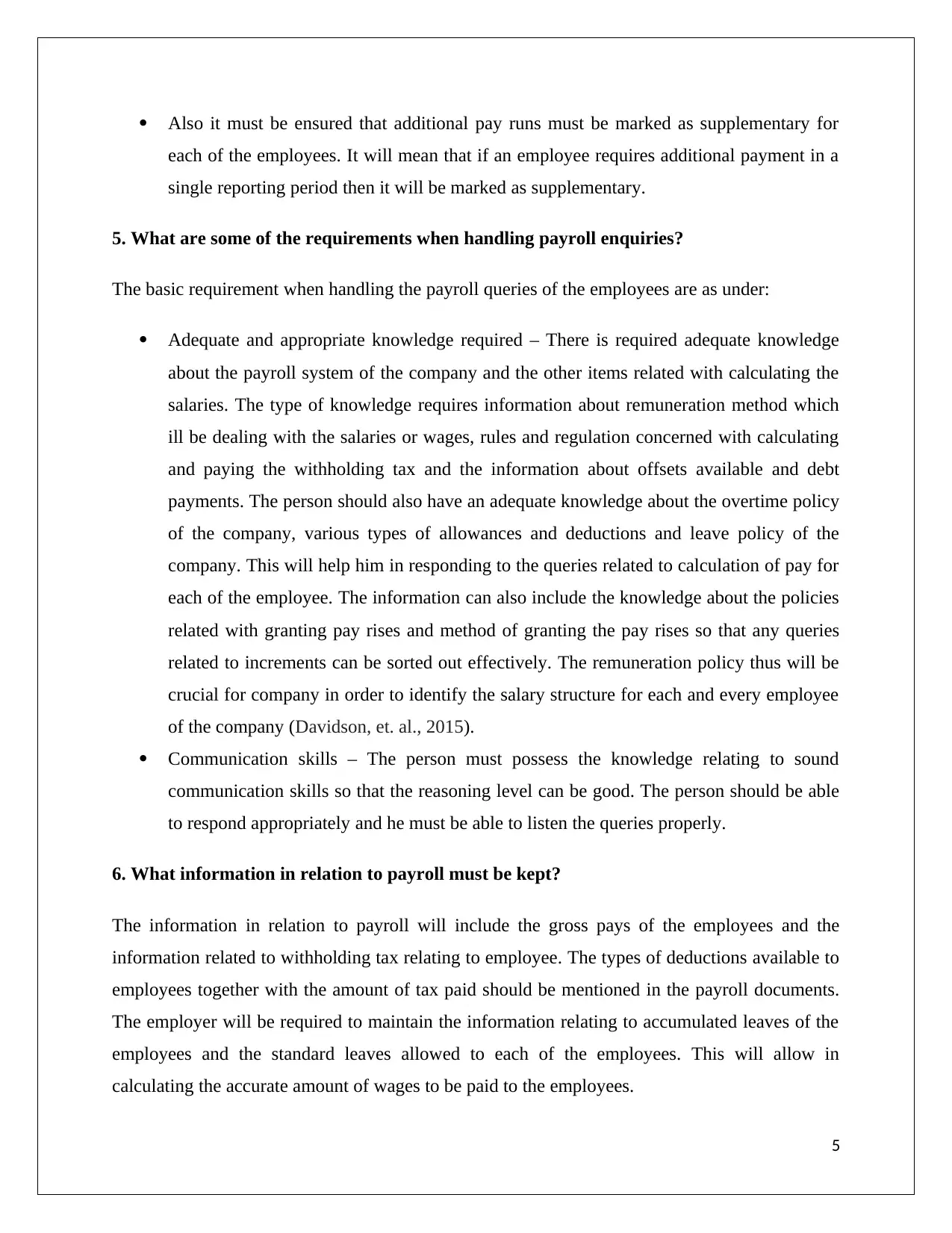
Also it must be ensured that additional pay runs must be marked as supplementary for
each of the employees. It will mean that if an employee requires additional payment in a
single reporting period then it will be marked as supplementary.
5. What are some of the requirements when handling payroll enquiries?
The basic requirement when handling the payroll queries of the employees are as under:
Adequate and appropriate knowledge required – There is required adequate knowledge
about the payroll system of the company and the other items related with calculating the
salaries. The type of knowledge requires information about remuneration method which
ill be dealing with the salaries or wages, rules and regulation concerned with calculating
and paying the withholding tax and the information about offsets available and debt
payments. The person should also have an adequate knowledge about the overtime policy
of the company, various types of allowances and deductions and leave policy of the
company. This will help him in responding to the queries related to calculation of pay for
each of the employee. The information can also include the knowledge about the policies
related with granting pay rises and method of granting the pay rises so that any queries
related to increments can be sorted out effectively. The remuneration policy thus will be
crucial for company in order to identify the salary structure for each and every employee
of the company (Davidson, et. al., 2015).
Communication skills – The person must possess the knowledge relating to sound
communication skills so that the reasoning level can be good. The person should be able
to respond appropriately and he must be able to listen the queries properly.
6. What information in relation to payroll must be kept?
The information in relation to payroll will include the gross pays of the employees and the
information related to withholding tax relating to employee. The types of deductions available to
employees together with the amount of tax paid should be mentioned in the payroll documents.
The employer will be required to maintain the information relating to accumulated leaves of the
employees and the standard leaves allowed to each of the employees. This will allow in
calculating the accurate amount of wages to be paid to the employees.
5
each of the employees. It will mean that if an employee requires additional payment in a
single reporting period then it will be marked as supplementary.
5. What are some of the requirements when handling payroll enquiries?
The basic requirement when handling the payroll queries of the employees are as under:
Adequate and appropriate knowledge required – There is required adequate knowledge
about the payroll system of the company and the other items related with calculating the
salaries. The type of knowledge requires information about remuneration method which
ill be dealing with the salaries or wages, rules and regulation concerned with calculating
and paying the withholding tax and the information about offsets available and debt
payments. The person should also have an adequate knowledge about the overtime policy
of the company, various types of allowances and deductions and leave policy of the
company. This will help him in responding to the queries related to calculation of pay for
each of the employee. The information can also include the knowledge about the policies
related with granting pay rises and method of granting the pay rises so that any queries
related to increments can be sorted out effectively. The remuneration policy thus will be
crucial for company in order to identify the salary structure for each and every employee
of the company (Davidson, et. al., 2015).
Communication skills – The person must possess the knowledge relating to sound
communication skills so that the reasoning level can be good. The person should be able
to respond appropriately and he must be able to listen the queries properly.
6. What information in relation to payroll must be kept?
The information in relation to payroll will include the gross pays of the employees and the
information related to withholding tax relating to employee. The types of deductions available to
employees together with the amount of tax paid should be mentioned in the payroll documents.
The employer will be required to maintain the information relating to accumulated leaves of the
employees and the standard leaves allowed to each of the employees. This will allow in
calculating the accurate amount of wages to be paid to the employees.
5
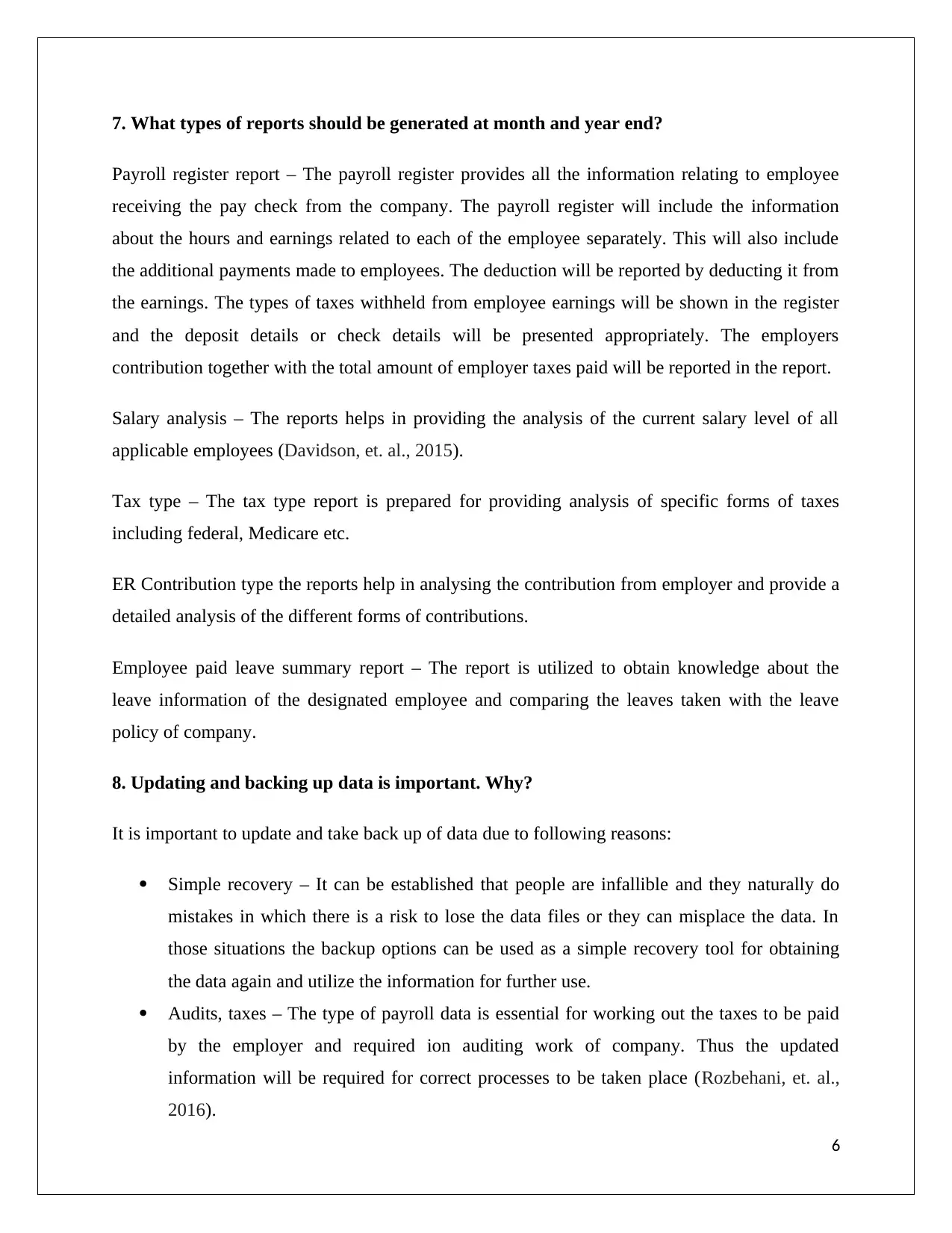
7. What types of reports should be generated at month and year end?
Payroll register report – The payroll register provides all the information relating to employee
receiving the pay check from the company. The payroll register will include the information
about the hours and earnings related to each of the employee separately. This will also include
the additional payments made to employees. The deduction will be reported by deducting it from
the earnings. The types of taxes withheld from employee earnings will be shown in the register
and the deposit details or check details will be presented appropriately. The employers
contribution together with the total amount of employer taxes paid will be reported in the report.
Salary analysis – The reports helps in providing the analysis of the current salary level of all
applicable employees (Davidson, et. al., 2015).
Tax type – The tax type report is prepared for providing analysis of specific forms of taxes
including federal, Medicare etc.
ER Contribution type the reports help in analysing the contribution from employer and provide a
detailed analysis of the different forms of contributions.
Employee paid leave summary report – The report is utilized to obtain knowledge about the
leave information of the designated employee and comparing the leaves taken with the leave
policy of company.
8. Updating and backing up data is important. Why?
It is important to update and take back up of data due to following reasons:
Simple recovery – It can be established that people are infallible and they naturally do
mistakes in which there is a risk to lose the data files or they can misplace the data. In
those situations the backup options can be used as a simple recovery tool for obtaining
the data again and utilize the information for further use.
Audits, taxes – The type of payroll data is essential for working out the taxes to be paid
by the employer and required ion auditing work of company. Thus the updated
information will be required for correct processes to be taken place (Rozbehani, et. al.,
2016).
6
Payroll register report – The payroll register provides all the information relating to employee
receiving the pay check from the company. The payroll register will include the information
about the hours and earnings related to each of the employee separately. This will also include
the additional payments made to employees. The deduction will be reported by deducting it from
the earnings. The types of taxes withheld from employee earnings will be shown in the register
and the deposit details or check details will be presented appropriately. The employers
contribution together with the total amount of employer taxes paid will be reported in the report.
Salary analysis – The reports helps in providing the analysis of the current salary level of all
applicable employees (Davidson, et. al., 2015).
Tax type – The tax type report is prepared for providing analysis of specific forms of taxes
including federal, Medicare etc.
ER Contribution type the reports help in analysing the contribution from employer and provide a
detailed analysis of the different forms of contributions.
Employee paid leave summary report – The report is utilized to obtain knowledge about the
leave information of the designated employee and comparing the leaves taken with the leave
policy of company.
8. Updating and backing up data is important. Why?
It is important to update and take back up of data due to following reasons:
Simple recovery – It can be established that people are infallible and they naturally do
mistakes in which there is a risk to lose the data files or they can misplace the data. In
those situations the backup options can be used as a simple recovery tool for obtaining
the data again and utilize the information for further use.
Audits, taxes – The type of payroll data is essential for working out the taxes to be paid
by the employer and required ion auditing work of company. Thus the updated
information will be required for correct processes to be taken place (Rozbehani, et. al.,
2016).
6
⊘ This is a preview!⊘
Do you want full access?
Subscribe today to unlock all pages.

Trusted by 1+ million students worldwide
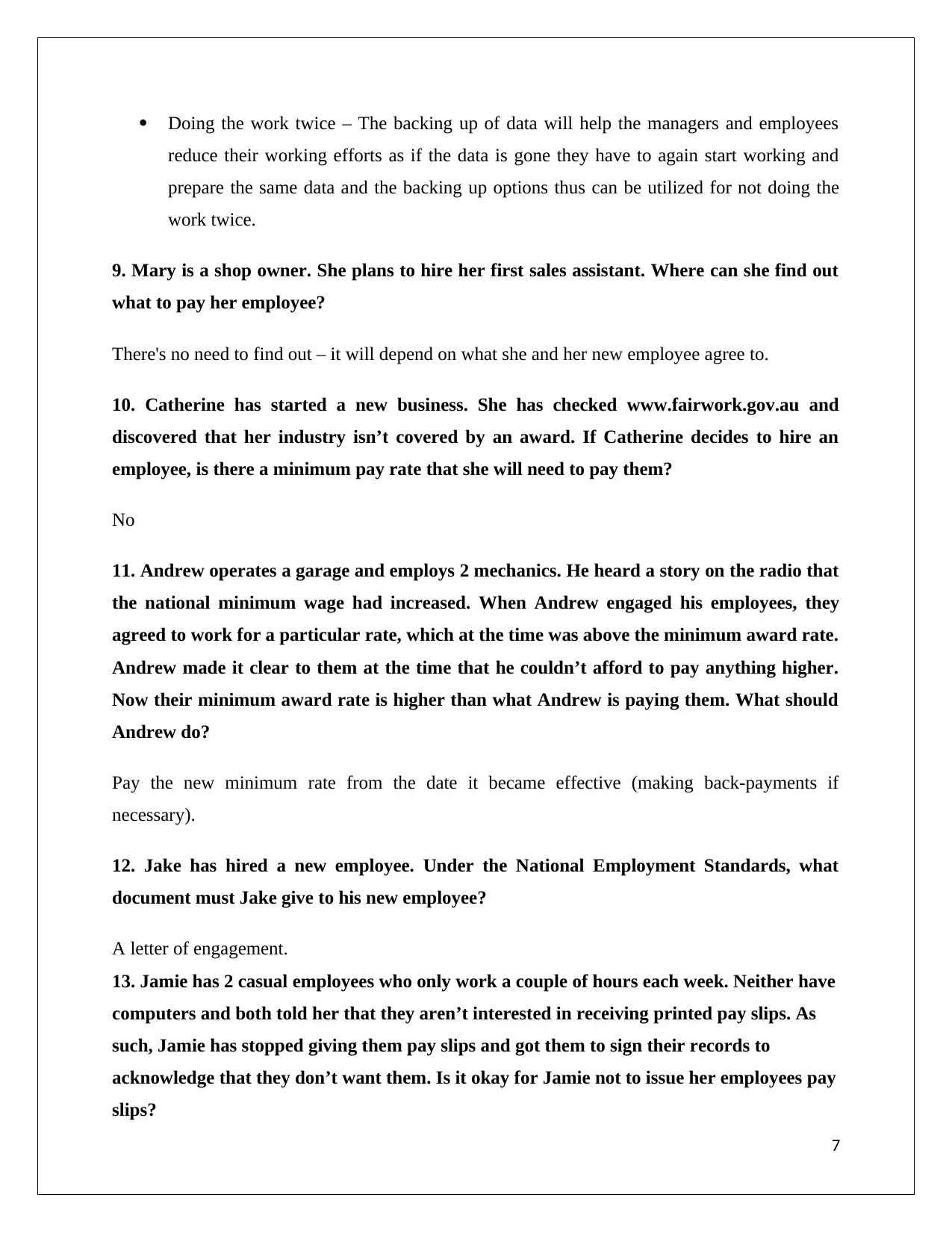
Doing the work twice – The backing up of data will help the managers and employees
reduce their working efforts as if the data is gone they have to again start working and
prepare the same data and the backing up options thus can be utilized for not doing the
work twice.
9. Mary is a shop owner. She plans to hire her first sales assistant. Where can she find out
what to pay her employee?
There's no need to find out – it will depend on what she and her new employee agree to.
10. Catherine has started a new business. She has checked www.fairwork.gov.au and
discovered that her industry isn’t covered by an award. If Catherine decides to hire an
employee, is there a minimum pay rate that she will need to pay them?
No
11. Andrew operates a garage and employs 2 mechanics. He heard a story on the radio that
the national minimum wage had increased. When Andrew engaged his employees, they
agreed to work for a particular rate, which at the time was above the minimum award rate.
Andrew made it clear to them at the time that he couldn’t afford to pay anything higher.
Now their minimum award rate is higher than what Andrew is paying them. What should
Andrew do?
Pay the new minimum rate from the date it became effective (making back-payments if
necessary).
12. Jake has hired a new employee. Under the National Employment Standards, what
document must Jake give to his new employee?
A letter of engagement.
13. Jamie has 2 casual employees who only work a couple of hours each week. Neither have
computers and both told her that they aren’t interested in receiving printed pay slips. As
such, Jamie has stopped giving them pay slips and got them to sign their records to
acknowledge that they don’t want them. Is it okay for Jamie not to issue her employees pay
slips?
7
reduce their working efforts as if the data is gone they have to again start working and
prepare the same data and the backing up options thus can be utilized for not doing the
work twice.
9. Mary is a shop owner. She plans to hire her first sales assistant. Where can she find out
what to pay her employee?
There's no need to find out – it will depend on what she and her new employee agree to.
10. Catherine has started a new business. She has checked www.fairwork.gov.au and
discovered that her industry isn’t covered by an award. If Catherine decides to hire an
employee, is there a minimum pay rate that she will need to pay them?
No
11. Andrew operates a garage and employs 2 mechanics. He heard a story on the radio that
the national minimum wage had increased. When Andrew engaged his employees, they
agreed to work for a particular rate, which at the time was above the minimum award rate.
Andrew made it clear to them at the time that he couldn’t afford to pay anything higher.
Now their minimum award rate is higher than what Andrew is paying them. What should
Andrew do?
Pay the new minimum rate from the date it became effective (making back-payments if
necessary).
12. Jake has hired a new employee. Under the National Employment Standards, what
document must Jake give to his new employee?
A letter of engagement.
13. Jamie has 2 casual employees who only work a couple of hours each week. Neither have
computers and both told her that they aren’t interested in receiving printed pay slips. As
such, Jamie has stopped giving them pay slips and got them to sign their records to
acknowledge that they don’t want them. Is it okay for Jamie not to issue her employees pay
slips?
7
Paraphrase This Document
Need a fresh take? Get an instant paraphrase of this document with our AI Paraphraser
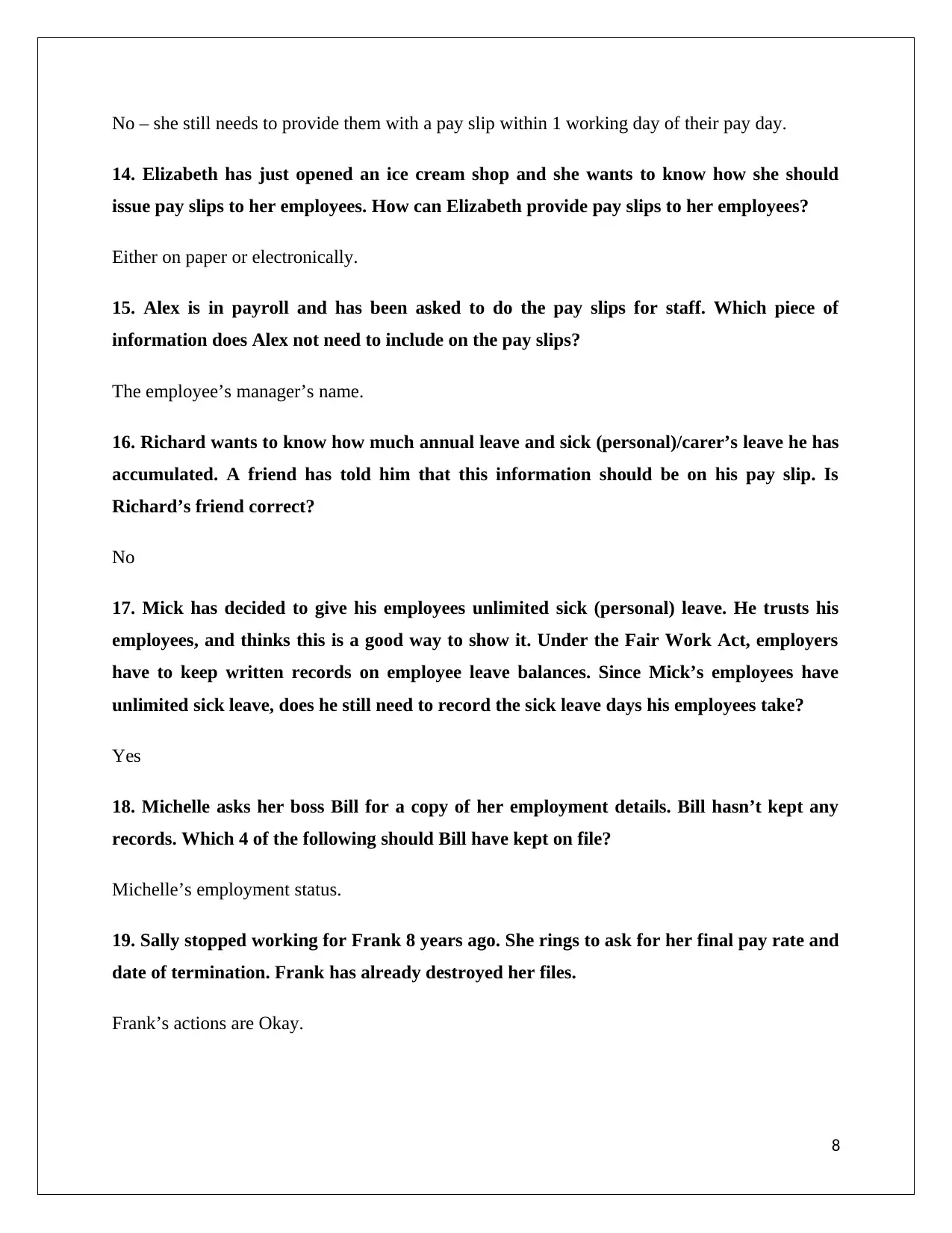
No – she still needs to provide them with a pay slip within 1 working day of their pay day.
14. Elizabeth has just opened an ice cream shop and she wants to know how she should
issue pay slips to her employees. How can Elizabeth provide pay slips to her employees?
Either on paper or electronically.
15. Alex is in payroll and has been asked to do the pay slips for staff. Which piece of
information does Alex not need to include on the pay slips?
The employee’s manager’s name.
16. Richard wants to know how much annual leave and sick (personal)/carer’s leave he has
accumulated. A friend has told him that this information should be on his pay slip. Is
Richard’s friend correct?
No
17. Mick has decided to give his employees unlimited sick (personal) leave. He trusts his
employees, and thinks this is a good way to show it. Under the Fair Work Act, employers
have to keep written records on employee leave balances. Since Mick’s employees have
unlimited sick leave, does he still need to record the sick leave days his employees take?
Yes
18. Michelle asks her boss Bill for a copy of her employment details. Bill hasn’t kept any
records. Which 4 of the following should Bill have kept on file?
Michelle’s employment status.
19. Sally stopped working for Frank 8 years ago. She rings to ask for her final pay rate and
date of termination. Frank has already destroyed her files.
Frank’s actions are Okay.
8
14. Elizabeth has just opened an ice cream shop and she wants to know how she should
issue pay slips to her employees. How can Elizabeth provide pay slips to her employees?
Either on paper or electronically.
15. Alex is in payroll and has been asked to do the pay slips for staff. Which piece of
information does Alex not need to include on the pay slips?
The employee’s manager’s name.
16. Richard wants to know how much annual leave and sick (personal)/carer’s leave he has
accumulated. A friend has told him that this information should be on his pay slip. Is
Richard’s friend correct?
No
17. Mick has decided to give his employees unlimited sick (personal) leave. He trusts his
employees, and thinks this is a good way to show it. Under the Fair Work Act, employers
have to keep written records on employee leave balances. Since Mick’s employees have
unlimited sick leave, does he still need to record the sick leave days his employees take?
Yes
18. Michelle asks her boss Bill for a copy of her employment details. Bill hasn’t kept any
records. Which 4 of the following should Bill have kept on file?
Michelle’s employment status.
19. Sally stopped working for Frank 8 years ago. She rings to ask for her final pay rate and
date of termination. Frank has already destroyed her files.
Frank’s actions are Okay.
8
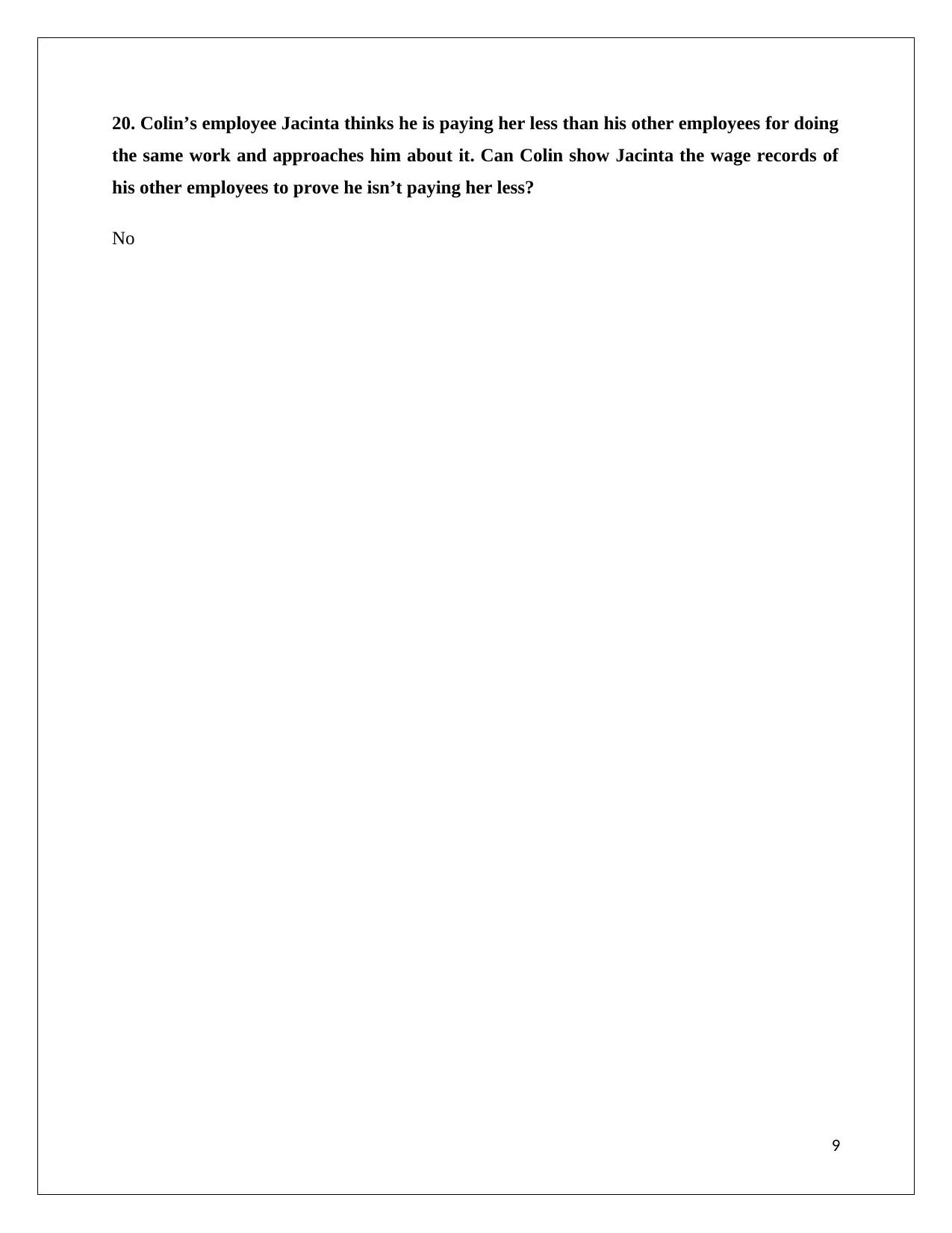
20. Colin’s employee Jacinta thinks he is paying her less than his other employees for doing
the same work and approaches him about it. Can Colin show Jacinta the wage records of
his other employees to prove he isn’t paying her less?
No
9
the same work and approaches him about it. Can Colin show Jacinta the wage records of
his other employees to prove he isn’t paying her less?
No
9
⊘ This is a preview!⊘
Do you want full access?
Subscribe today to unlock all pages.

Trusted by 1+ million students worldwide
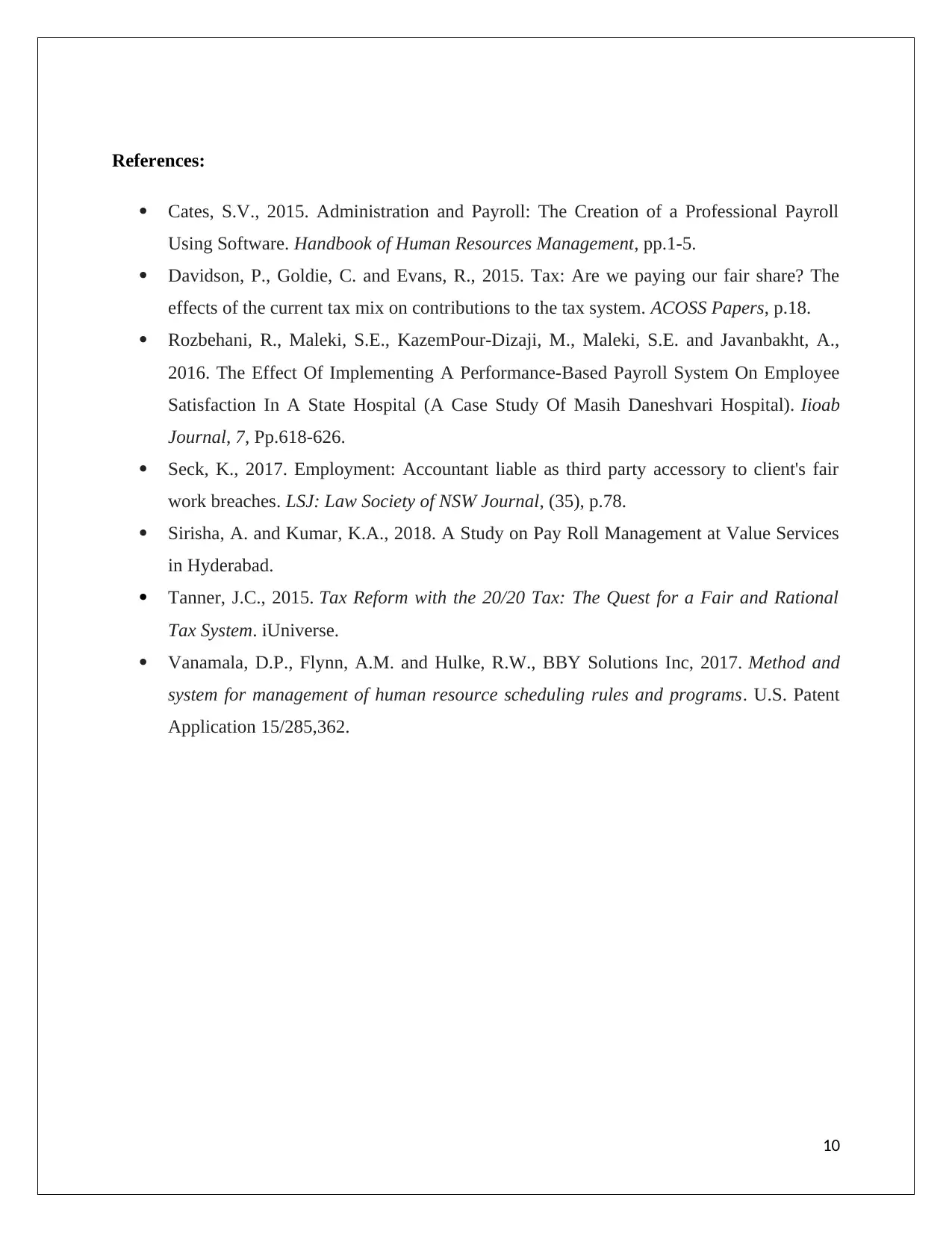
References:
Cates, S.V., 2015. Administration and Payroll: The Creation of a Professional Payroll
Using Software. Handbook of Human Resources Management, pp.1-5.
Davidson, P., Goldie, C. and Evans, R., 2015. Tax: Are we paying our fair share? The
effects of the current tax mix on contributions to the tax system. ACOSS Papers, p.18.
Rozbehani, R., Maleki, S.E., KazemPour-Dizaji, M., Maleki, S.E. and Javanbakht, A.,
2016. The Effect Of Implementing A Performance-Based Payroll System On Employee
Satisfaction In A State Hospital (A Case Study Of Masih Daneshvari Hospital). Iioab
Journal, 7, Pp.618-626.
Seck, K., 2017. Employment: Accountant liable as third party accessory to client's fair
work breaches. LSJ: Law Society of NSW Journal, (35), p.78.
Sirisha, A. and Kumar, K.A., 2018. A Study on Pay Roll Management at Value Services
in Hyderabad.
Tanner, J.C., 2015. Tax Reform with the 20/20 Tax: The Quest for a Fair and Rational
Tax System. iUniverse.
Vanamala, D.P., Flynn, A.M. and Hulke, R.W., BBY Solutions Inc, 2017. Method and
system for management of human resource scheduling rules and programs. U.S. Patent
Application 15/285,362.
10
Cates, S.V., 2015. Administration and Payroll: The Creation of a Professional Payroll
Using Software. Handbook of Human Resources Management, pp.1-5.
Davidson, P., Goldie, C. and Evans, R., 2015. Tax: Are we paying our fair share? The
effects of the current tax mix on contributions to the tax system. ACOSS Papers, p.18.
Rozbehani, R., Maleki, S.E., KazemPour-Dizaji, M., Maleki, S.E. and Javanbakht, A.,
2016. The Effect Of Implementing A Performance-Based Payroll System On Employee
Satisfaction In A State Hospital (A Case Study Of Masih Daneshvari Hospital). Iioab
Journal, 7, Pp.618-626.
Seck, K., 2017. Employment: Accountant liable as third party accessory to client's fair
work breaches. LSJ: Law Society of NSW Journal, (35), p.78.
Sirisha, A. and Kumar, K.A., 2018. A Study on Pay Roll Management at Value Services
in Hyderabad.
Tanner, J.C., 2015. Tax Reform with the 20/20 Tax: The Quest for a Fair and Rational
Tax System. iUniverse.
Vanamala, D.P., Flynn, A.M. and Hulke, R.W., BBY Solutions Inc, 2017. Method and
system for management of human resource scheduling rules and programs. U.S. Patent
Application 15/285,362.
10
1 out of 10
Related Documents
Your All-in-One AI-Powered Toolkit for Academic Success.
+13062052269
info@desklib.com
Available 24*7 on WhatsApp / Email
![[object Object]](/_next/static/media/star-bottom.7253800d.svg)
Unlock your academic potential
Copyright © 2020–2025 A2Z Services. All Rights Reserved. Developed and managed by ZUCOL.





